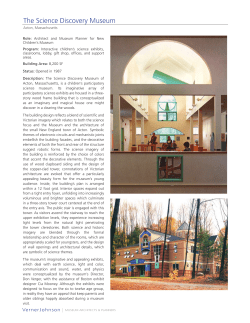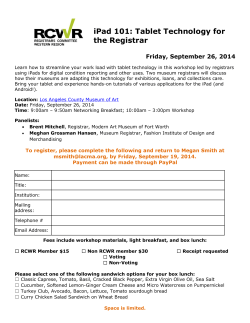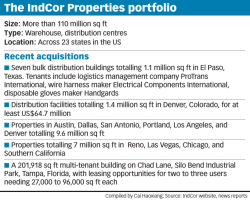
! PRESS RELEASE Cai Guo-Qiang
! ! PRESS RELEASE ! Cai Guo-Qiang 20 November, 2014 – 10 January, 2015 Opening: 20 November 6-8 p.m. ! ! Unit D,15/F Entertainment Building 30 Queen's Road Central Hong Kong tel +852 2503 2220 info@axelvervoordtgallery.com.hk www.axelvervoordtgallery.com ! ! ! ! ! ! ! ! ! The artistic language Cai Guo-Qiang (b. 1957, Chinese) developed with gunpowder drawing is exceptional in his choice of material and work process. It's comparable to that of an alchemist rather than a painter in traditional art historical context. He transforms his experiences, memories, traditions, Eastern philosophy and history into a narrative with symbolic images through gunpowder explosions. He draws, cuts, recomposes stencils and lays them on paper to apply gunpowder. Once lit by the artist, a blaring explosion follows—a moment of chaos—and then what was invisible before becomes visible afterwards. The whole process has ritual and spiritual aspects transcending boundaries of the seen and unseen world. It subsequently makes viewers contemplate watching over the steps from the beginning until the end of the explosion. ! Elements of chance and accident come into play due to the unpredictable characteristics of gunpowder. And it naturally makes his drawings more original and automatic. Gunpowder carries the power to destruct as well as to reconstruct. Although there are compositions and figures in his gunpowder works, just like ordinary drawings or paintings, it’s the energy that he attempts to depict not the figure itself. It was from 1986 to 1995 while living in Japan he started to explore the material more seriously and make his name as ‘gunpowder artist’. Subject matter has been changing over the decades, but the gunpowder became his signature medium taking up a site-specific approach to culture, history, humanism, and universality in a larger scale. ! The artist often says using gunpowder brings him closer to the nature and even to the universe. This methodology Cai uses for his gunpowder drawings ranges across understanding of time and space. Gunpowder is one of the most Chinese materials from ancient time since its invention in the 8-9th century. It comes from soil—part of the earth—and when it's ignited by fire (one of the elements formed the universe) it creates something new and unexpected. His interests in cosmology, ancient science, and ! ! ! history are all incorporated in his work. This narrative crosses borders between the east and the west, from civilization to civilization. ! “Chun Qiu: Bygones” (2006) was created when Cai participated in the inaugural exhibition of the newly designed Suzhou Museum (Suzhou, China), where he exhibited a group of works titled, "Searching for Dreams in the Canals.” And “Impression of Stage One" (2006) was created as part of a project called “Stage”, that artist made in San Gimignano, Italy, for his first solo exhibition at Galleria Continua. From the two different, beautiful historical backdrops and landscapes, Cai is paying homage to each city’s legacy. Both works draw on the history and civilization of humankind seeking oneness of humanity, history and nature through the works—one from the east and the other from the west—it evokes how small and ephemeral we are compared to the nature and the universe. ! Cai Guo-Qiang is one of the most influential Chinese contemporary artists of his time. He was born in 1957 in Quanzhou, Fujian Province, China, and is currently living and working in New York City. He studied stage design at the Shanghai Theater Academy from 1981 to 1985, and attended the Institute for Contemporary Art: The National and International Studio Program at P.S.1 Contemporary Art Center, Long Island City in 1995. He represented his country at the 48th Venice Biennale in 1999 and was awarded the Golden Lion. He also curated the first China Pavilion at the 51st Venice Biennale in 2005. He received the 7th Hiroshima Art Prize (2007), the 20th Fukuoka Asian Culture Prize (2009), and was appointed as the director of visual and special effects for the opening and closing ceremonies of the 2008 Summer Olympics in Beijing. The International Association of Art Critics awarded him Best Project in a Public Space for his work “Fallen Blossoms” (2010). He also awarded the Praemium Imperiale in Tokyo as the first Chinese national Laureate in 2012. Among numerous solo/retrospective exhibitions at internationally renowned museums and institutions there are: Cai Guo-Qiang: Sky Ladder, Museum of Contemporary Art, Los Angeles (2012), Cai Guo-Qiang: Saraab, Mathaf: Arab Museum of Modern Art, Doha, Qatar (2011), I Want to Believe, Solomon R. Guggenheim Museum, New York (2008), Cai GuoQiang on the Roof: Transparent Monument, Metropolitan Museum of Art, New York (2006). ! For more information contact: ! Mi Jeong Kim mj@axelvervoordtgallery.com.hk +852 2503 2220 ! Anne-Sophie Dusselier asd@axel-vervoordt.com +32 3 680 14 89 ! !
© Copyright 2025










